Zosma, Delta Leonis (δ Leo), is a white subgiant star located in the constellation Leo. With an apparent magnitude of 2.56, it is the fourth brightest star in Leo, after Regulus, Denebola, and Algieba. Zosma lies at a distance of 58.4 light years from Earth. It marks the hip of the celestial Lion.
Star type
Zosma has the stellar classification A5IV(n), indicating a white subgiant star. It is twice as large and massive as the Sun, with a radius of 2.14 solar radii and a mass of 2.2 solar masses. With an effective temperature of 8,296 K, it shines with 15.5 solar luminosities.
Zosma is a fast spinner. With a projected rotational velocity of 180 km/s, it rotates 90 times faster than the Sun and takes less than a day to complete a rotation. As a result of its high rotation rate, the star has the shape of an oblate spheroid, just like its brighter fast-spinning neighbours Regulus and Denebola. Zosma’s polar radius is only 84% of its equatorial radius.
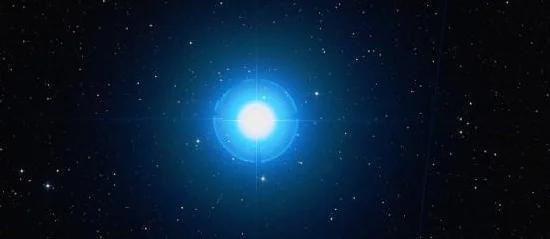
Zosma (Delta Leonis), image: Wikisky
The star’s estimated age is between 600 and 750 million years. Even though it is much younger than the Sun, being twice as massive, Zosma will have a much shorter lifespan. After spending a billion years on the main sequence, it will evolve into an orange giant. It is not massive enough to end its life as a supernova. Instead, it will eventually cast off its outer layers and gradually fade away as a dim white dwarf.
Delta Leonis is classified as a Delta Scuti variable. Also known as dwarf Cepheids, Delta Scuti stars vary in brightness due to pulsations. Since they follow a period-luminosity relation, they are used as standard candles for determining distances to other astronomical objects. Other than the prototype Delta Scuti, stars in this class include Altair in the constellation Aquila, Caph in Cassiopeia, Seginus in Boötes, Epsilon Cephei in Cepheus, and Polaris Australis in Octans. The bright Vega in Lyra and Denebola in Leo are suspected members of the class.
Facts
Zosma is the fourth brightest point of light in Leo but individually it is the constellation’s third brightest star. With an apparent magnitude of 2.56, it outshines both components of the Gamma Leonis (Algieba) system. Gamma Leonis has a combined magnitude of 2.08, but individually its two giants shine at magnitudes 2.37 and 3.64. Individually, Zosma is only fainter than Regulus (mag. 1.40) and Denebola (mag. 2.113).
Zosma is a suspected member of the Ursa Major Moving Group (Collinder 285), a stellar association that includes most of the bright stars of Ursa Major (all Big Dipper stars except Dubhe and Alkaid), as well as Alphecca in the constellation Corona Borealis, Beta Serpentis in Serpens, Menkalinan in Auriga, Skat in Aquarius, Gamma Leporis in Lepus, and Zeta Boötis in Boötes. These stars are believed to have formed in the same molecular cloud at about the same time and share a common motion through space. Group members have an average age of 500 million years.
Name
The name Zosma (pronunciation: /ˈzɒzmə/) comes from the Greek zosma or zoma, meaning “the girdle.” It refers to the star’s position in the constellation Leo, marking the lion’s hip or hump. The name was also historically spelled Zozma and Zozca.
The name was approved by the International Astronomical Union’s (IAU) Working Group on Star Names (WGSN) on July 20, 2016.
Zosma was traditionally also known as Duhr or Dhur. The name is derived from the Arabic word for “back” and refers to the lion’s back. The 15th century Timurid astronomer Ulugh Beg called the star Al Thahr al Asad, meaning “the lion’s back.”
Delta Leonis once shared the names Zubra or Al Zubrah (“the mane”), Wadha (“the wise”), and Al Kahil al Asad (“the space between the lion’s shoulders”) with its neighbour Theta Leonis (Chertan).
The Chinese know Zosma as 太微右垣五 (Tài Wēi Zuǒ Yuán wu), the Fifth Star of Right Wall of Supreme Palace Enclosure. The Right Wall of Supreme Palace Enclosure is a Chinese asterism formed by Zosma with Chertan (Theta Leonis), Iota Leonis, Sigma Leonis and Zavijava (Beta Virginis). The Supreme Palace Enclosure is one of Three Enclosures in Chinese astronomy. It represents the imperial court. The stars symbolize five guardians on the Right Wall. Delta Leonis represents 西上相 (Xīshǎngxiāng), the First Western Minister.
Location
Zosma is easy to find because it is part of Leo’s distinctive figure. The star marks the lion’s hip and lies just east (left) of the Sickle of Leo, an asterism that forms the lion’s head, mane and shoulders, and northwest of the slightly brighter Denebola at the lion’s tail. It forms a triangle with Denebola and Chertan.
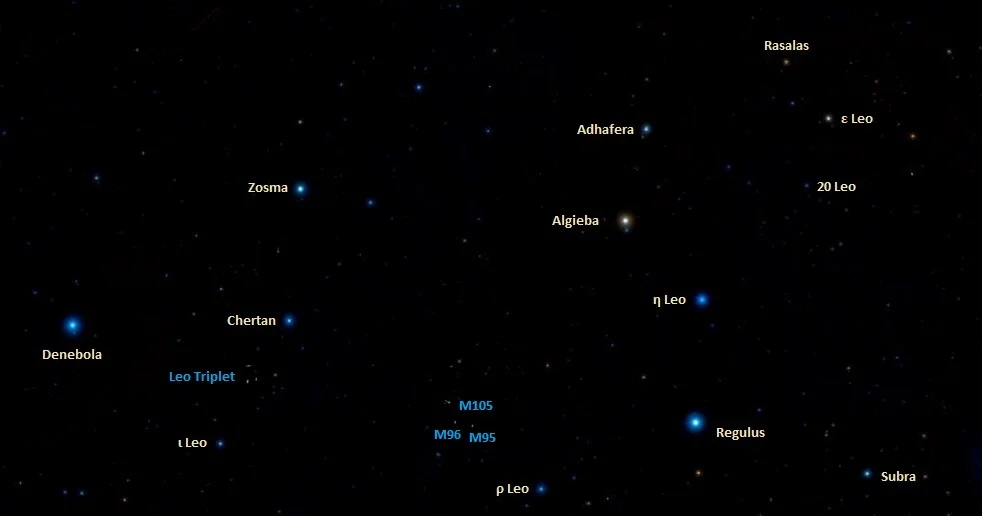
Leo stars, image: Wikisky
The Sickle can be found using Megrez and Phecda, the inner stars of the Big Dipper’s bowl. A line extended from Megrez through Phecda leads to Regulus, the star at the base of the Sickle.
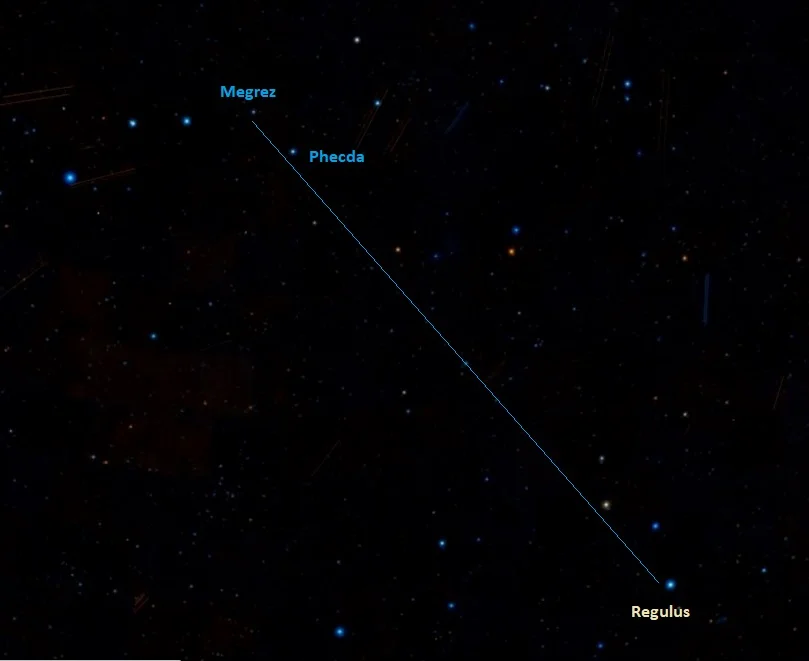
The Big Dipper and the Sickle of Leo, image: Wikisky
Zosma can be used to find the pair of galaxies catalogued as NGC 3588. The two galaxies – one spiral and the other lenticular – lie approximately 65 million light years away and have apparent magnitudes of 14.5 and 15.0. They appear just south of Zosma.
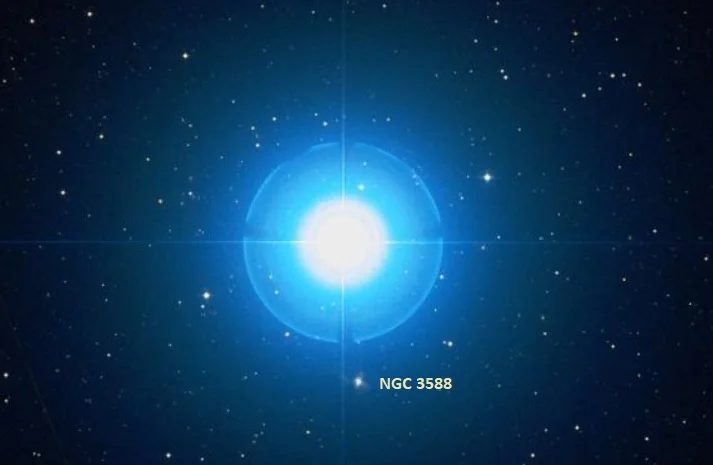
Zosma and NGC 3588, image: Wikisky
Constellation
Zosma is located in the constellation Leo. Leo is one of the Greek constellations, first catalogued by Ptolemy of Alexandria in his Almagest in the 2nd century CE. It is the 12th largest constellation in the sky, with an area of 947 square degrees. It represents the Nemean lion, one Heracles’ Twelve Labours.
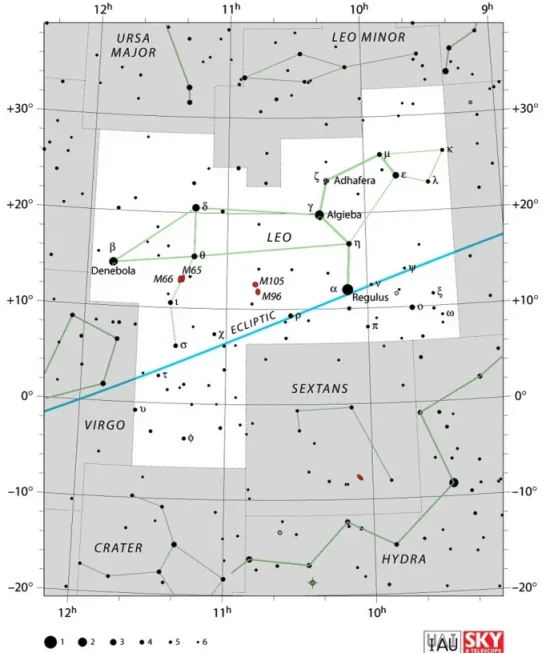
Leo constellation map by IAU and Sky&Telescope magazine
Leo is also one of the most recognizable constellations, with the Sickle asterism forming the lion’s head, Regulus marking the heart, Zosma and Chertan the rump, and Denebola the tail.
The constellation is best-known for its bright stars Regulus, the 21st brightest star in the sky, and Denebola, which is used to find the Virgo Cluster of galaxies. Other notable stars in Leo include Wolf 359, a red dwarf only 7.86 light years away, the white supergiant Eta Leonis, the carbon star CW Leonis, Icarus (MACS J1149 LS1), one of the most distant stars known, the variable red giant R Leonis, and Caffau’s Star (SDSS J102915+172927), one of the oldest known stars in our galaxy, with an estimated age of 13 billion years.
Leo is also known for its bright galaxies. The best-known ones are the Leo I Group (Messier 96 Group), whose brightest members are Messier 95, Messier 96 and Messier 105, and the Leo Triplet, formed by the galaxies Messier 65, Messier 66 and NGC 3628. Other galaxies in Leo include the Owl Galaxy (NGC 3758), the colliding pair NGC 3226 and NGC 3227, the Silverado Galaxy (NGC 3370), and the elliptical galaxy NGC 3842, the brightest member of the Leo Cluster (Abell 1367) and keeper of one of the largest black holes known. Leo also contains a gravitationally lensed system of two galaxies known as the Cosmic Horseshoe, discovered in 2007, and the Frosty Leo Nebula, a relatively bright protoplanetary nebula.
The best time of year to see the stars and deep sky objects in Leo is during the month of April, when the constellation is prominent in the evening sky. The entire constellation is visible from locations between the latitudes 90° N and 65° S.
The 10 brightest stars in Leo are Regulus (Alpha Leo, mag. 1.40), Algieba (Gamma Leo, mag. 2.08), Denebola (Beta Leo, mag. 2.113), Zosma (Delta Leo, mag. 2.56), Epsilon Leonis (mag. 2.98), Chertan (Theta Leo, mag. 3.324), Adhafera (Zeta Leo, mag. 3.33), Eta Leonis (mag. 3.486), Subra (Omicron Leo, mag. 3.52), and Shaomin (Rho Leo, mag. 3.9).
Zosma – Delta Leonis
| Spectral class | A5IV(n) |
| Variable type | Delta Scuti |
| U-B colour index | +0.12 |
| B-V colour index | +0.12 |
| Apparent magnitude | 2.56 |
| Absolute magnitude | +1.29 |
| Distance | 58.4 ± 0.3 light years (17.91 ± 0.08 parsecs) |
| Parallax | 55.82 ± 0.25 mas |
| Radial velocity | -20.90 ± 0.6 km/s |
| Proper motion | RA: +143.42 ± 0.30 mas/yr |
| Dec.: -129.88 ± 0.21 mas/yr | |
| Mass | 2.2 M☉ |
| Luminosity | 15.5 ± 1.8 L☉ |
| Radius | 2.14 ± 0.040 R☉ |
| Temperature | 8,296 K |
| Age | 0.60 – 0.75 billion years |
| Rotational velocity | 180 km/s |
| Surface gravity | 3.91 cgs |
| Constellation | Leo |
| Right ascension | 11h 14m 06.50142s |
| Declination | 20° 31′ 25.3853″ |
| Names and designations | Zosma, Delta Leonis, δ Leo, 68 Leonis, HD 97603, HR 4357, HIP 54872, SAO 81727, FK5 422, BD +21°2298, PPM 100996, GC 15438, GCRV 6892, AG+20 1243, LTT 13027, NLTT 26691, PLX 2614.00, Gl 419, JP11 2038, 2MASS J11140651+2031258, UBV 10242, TYC 1439-2479-1, BDS 5709 A, CCDM J11141+2032A, IDS 11088+2104 A, WDS J11141+2031A |